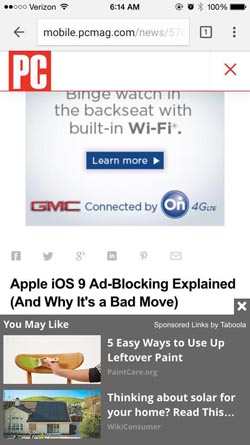September 19, 2015
Readers are rebelling, and publishers better listen to them

If you go to Apple’s web page to find out what’s new in the latest version of the software that runs its iPhones and iPads, you’ll find no mention at all about content blockers.
And yet this is the iOS 9 feature that appears to be the most popular. You can now go to the App Store and download an app that blocks all the ads on websites you visit. These apps, which you typically have to pay for, are already topping the charts.
So what does it say when people stampede to pay for something? In our free enterprise system, where consumers vote with their money, it tells me that there are a lot of people fed up with increasingly intrusive advertising.
I recently clicked on a link in my iPhone that took me to a website where an ad immediately took over the page and used up so many resources that it killed the battery and the screen went blank. I can’t be the only one who has an experience like this. No wonder ad blockers are popular.
The readers are rebelling.
Many publishers, of course, are worried that if fewer people see their ads then revenues will drop and they won’t be able to afford to stay in business. To be fair, advertising does seem to be the main way to make money on the Internet these days, but it’s also true that the customer is always right. It can’t possibly be considered a good business model to do things you know annoy your readers.
Even so, CNet doesn’t seem to have learned this lesson. If you try to watch one of their videos with an ad blocker enabled, you get turned away by an obnoxious black screen. All that’s going to do is convince people that they should turn elsewhere for their news.
The problem with the Internet is that there is almost infinite supply. Demand has gone up with the convenience of mobile devices but it will never be infinite. In a situation like this, it’s really hard to make money. So publishers and advertisers increasingly resort to desperate measures. With an abundance of content, customers respond by exercising the option of moving on. Or, as is happening with the iPhone, smart app developers give them what they want — a nice, simple reading experience.
Publishers will have no choice but to adapt to the demands of their readers. It’s always been that way.
Most websites get their advertising by signing up with a company that supplies the ads. The people who run these networks should be scrambling to come up with a solution that makes readers — and, by extension, publishers — happy. Otherwise they’ll become obsolete.
Their biggest obstacle is that they measure success with “views.” If someone sees a web page with ad on it, that counts as a view — even if they didn’t actually look at the ad or absorb what was in it. It’s a shotgun approach. If you keep firing randomly, you’re bound to hit something. There has to be a better way.
In fact we might already have a solution on the horizon based on the success of La Presse, a long-time daily newspaper in Montreal that has announced that its iPad app has become so successful that it is cutting back print publication to once a week in January. They are now in the midst of helping the Toronto Star follow in their footsteps.
What’s different about the La Presse model is that it concentrates on creating a wonderful experience for readers, with advertising integrated into that experience. The main selling point for advertisers is engagement. People are willing to spend a lot of time with an app that treats them like valued customers rather just another pair of eyeballs for products they don’t want or need.
Imagine a future where La Presse sells affordable turnkey solutions like this to publishers large and small. This is the kind of innovation that will win.
